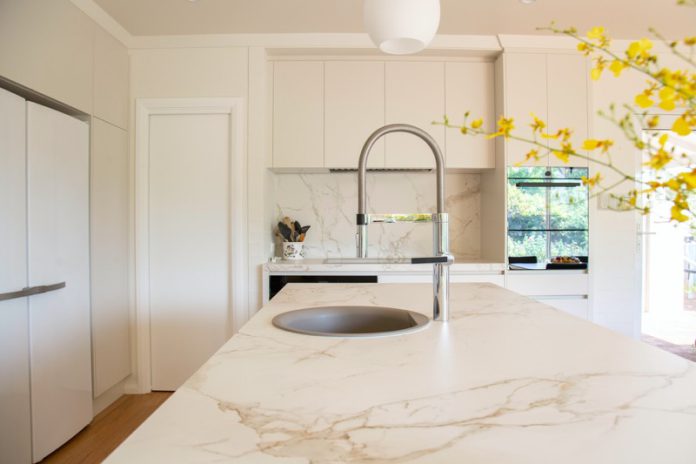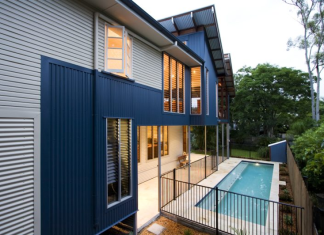Epoxy is a chemical compound you can apply over the old and worn countertop to give it a new and glossy look. Epoxy countertops are becoming popular because of their durability and high-end look.
Another reason for the popularity of epoxy is its low cost. Applying epoxy on the countertop is much cheaper than buying a new countertop. Epoxy over tile countertops is the perfect choice for homeowners who want to give their countertops a marble or granite look at a low cost. Applying epoxy over a tile countertop creates a fabulous high-end look for a fraction of the cost and can be done in the kitchen or bathroom”, said Shaun Martin, a Denver cash home buyer who you can get a fair cash offer from to sell your house fast at https://
You need to buy an epoxy countertop kit, which usually contains two bottles. One has resin and the other a hardener. In this guide, you will learn the exact method of applying epoxy over the tile countertop. Below are some common mistakes that can cause various problems when working with epoxy.
Common mistakes to avoid
Below are common mistakes people make during epoxy coating over the tile countertop. You can avoid these mistakes to give your countertop a captivating look.
Room temperature below 70 degrees: To get it right, make sure that the temperature of the room and epoxy must be between 70 to 75 degrees. You will not get desired results in case of inconsistent temperature. After pouring the epoxy on the surface, you need to maintain the room temperature mentioned above for another 24 hours to cure the epoxy countertop properly.
Not mixing epoxy: Mixing epoxy resin is necessary. Mix it for 3 minutes in a container to avoid eternal sticky spots and bubbles on the countertop surface.
Improper Measurement: The Epoxy countertop has a 1:1 ratio. For a durable finished surface, ensure you get the correct ratio. You can find the details of the mixing ratio for epoxy resin on the container or packaging.
Below are some other mistakes one ought to avoid when applying epoxy over the tile countertop.
- Miscalculated Epoxy Amounts
- Not preparing the surface properly
- Not storing epoxy at the appropriate temperature
Below is the exact method of pouring an epoxy coating over tile countertops.
Purchase epoxy product
You need to buy and clear epoxy over the tile countertop kit, which usually contains two bottles. One has resin, and the other has a hardener. Make sure to purchase a high-quality epoxy product to get the best results. Caesarstone has a detailed article on epoxy countertops. Read the article before buying epoxy. You can also read the review of the best epoxy products for countertops here.
Tools and material required for epoxy coating over tile countertops
The tools needed for Epoxy coating over tile countertops include a 6-in paint roller, orbital sander brushes, drill, trim router, and oscillating tool are essential tools required for epoxy coating over tile countertops. Materials needed for epoxy countertop are 80- and 220-grit sanding sponge, four 1-qt. cups, tape, plastic sheet, spray bottle, two 2-gallon buckets, two 6-in. 3/8-in.-nap roller sleeves, two paddle mixers, wiping cloths, etc.
Remove the tile backsplash (optional): If you want the elegant look of your marble on the countertop, then you may want to remove the backsplash of your countertop. An oscillating tool and a carbide blade are perfect for this work. Also, don’t forget to fill gaps between the countertop and the wall with wood glue or sawdust.
Remove your sink: If you have a sink on your countertop, make sure to remove it. In this way, your sink will be safe from epoxy, and it will be easy for you to tape.
Route the corners of the countertop: Your epoxy countertop may look ugly with the sharp corners. Therefore, It’s advisable to round the corners because rounded corners are perfect for epoxy countertops.
Fill out seams: Make sure to fill out all the corners and gaps.
Sand the surface: After filling the gaps and seams with a paint scraper, you may notice high spots in the body filler. Use 60-grit sandpaper to sand the rounded corners, top, and front edge.
Masking: Endeavour to mask everything you don’t want to spoil. Tape the plastic sheet on the floor beneath the countertop. Also, cover walls with the sheet.
Prepare the material: Before applying and coating epoxy over the tile countertop, check whether all the required material is available and ready to be used or not.
Apply primer: Mix two-part primer in the bucket, then roll it over the countertop and the edge as well. Again apply the primer on the counter if you still see old color somewhere on the countertop.
Pre mIx the highlights: After that, wait for an hour before it gets fully sticky. Meanwhile, you can mix the metal powder in an epoxy resin, but don’t mistake mixing the hardener until you are ready to apply epoxy.
Apply the base coat of epoxy: Before applying the base coat, make sure the surface is tacky. It’s best to mix epoxy in two different buckets with a clean and stocky stick. After that, pour enough epoxy on the countertop and then spread it around with the help of a roller.
Make sure to roll the edges: Don’t forget to apply the epoxy on the edge of the countertop. Make sure epoxy covers every part of your countertop.
Add highlights: Mix highlights for 2 to 3 minutes to give your countertop an elegant look. After mixing, pour the highlights on the surface of the countertop. Before applying more highlights, make sure whether your countertop needs more highlights or not because you can’t remove it if you pour highlights too much.
Dragging highlights: Drag the highlights slightly with a brush to create a unique design on the countertop surface. Epoxy can blend with highlights. So, it’s best to cure the base coat of epoxy before applying the highlights on the surface.
Sweep off drips: Sweep off drips hanging down from the leading edge of the countertop. In case of any bugs or dust on the surface, use a toothpick to remove them.
Protective topcoat: The last step is to apply the topcoat on the surface of the countertop. But you need to wait for 20 hours before performing the topcoat. The next day, make sure the surface is clean of dust and drips. Next, mix the topcoat in a container and pour it on the surface. Spread the coat around quickly with a roller. It will take a week for the countertop to set up.
Safety tips for applying epoxy over tile countertops
- To protect your eyes against splashes, use chemical goggles with side shields.
- Wear gloves before starting the work. Wash your hands before and after each use of gloves to prevent any side effects of chemicals.
- To protect your skin from harmful chemicals, cover your body with a coverall, also known as a boilersuit.
- Wear boots to protect your skin in case of chemicals falling on your foot.
Conclusion
That’s it! Now you have sufficient knowledge to apply epoxy over the tile countertop. Overall, epoxy countertops are good, but they are not as durable as marble or granite. If you decide to pour epoxy over your countertop, we encourage you to consult with professionals of epoxy countertops such as Caesarstone to avoid severe problems.














